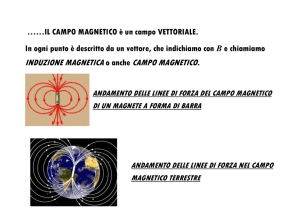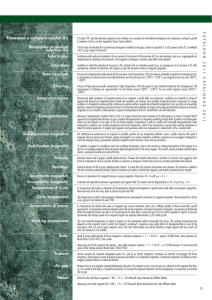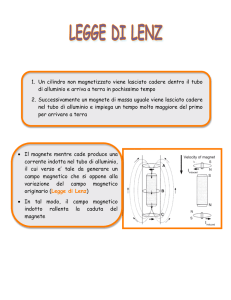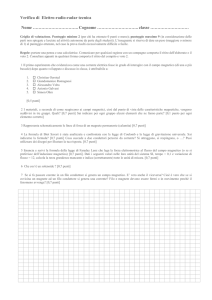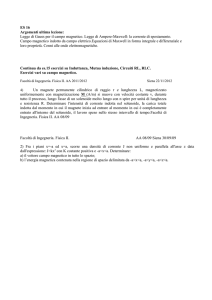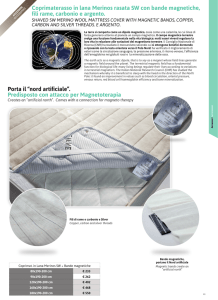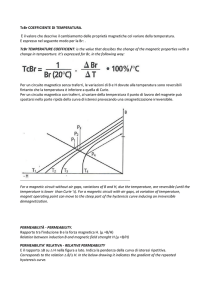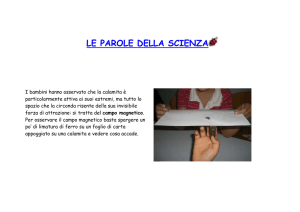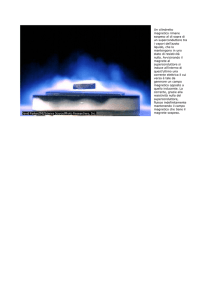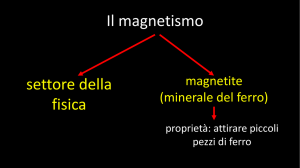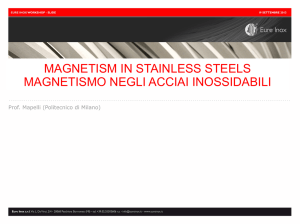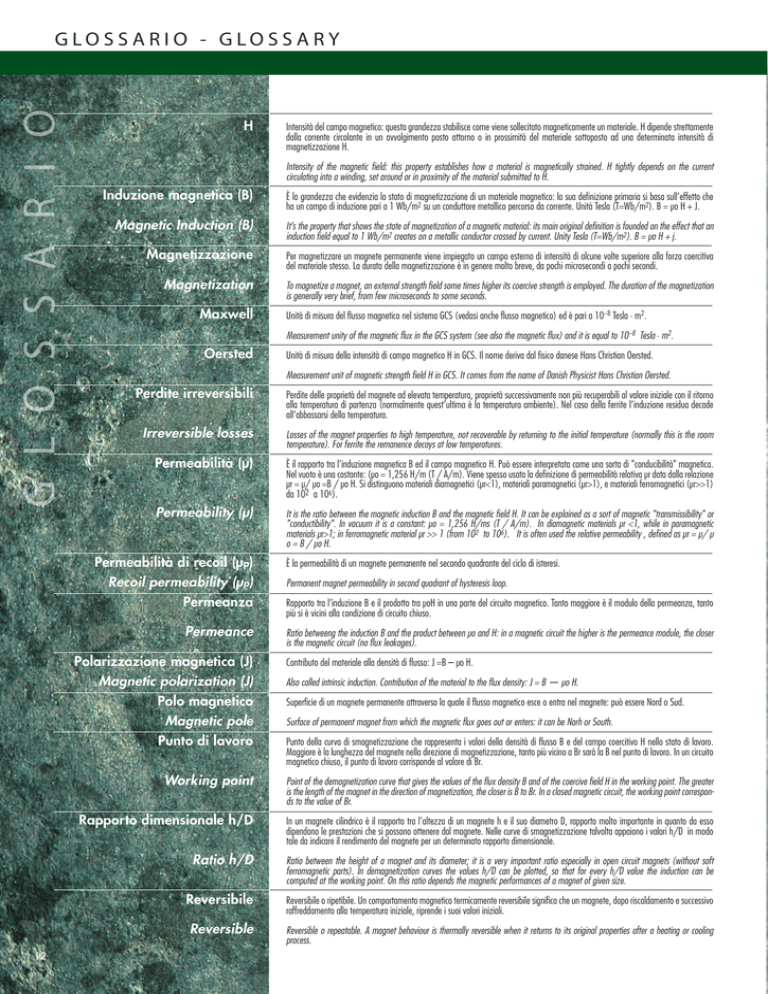
G L O S S A R I O
GLOSSARIO - GLOSSARY
H
Intensity of the magnetic field: this property establishes how a material is magnetically strained. H tightly depends on the current
circulating into a winding, set around or in proximity of the material submitted to H.
Induzione magnetica (B)
È la grandezza che evidenzia lo stato di magnetizzazione di un materiale magnetico: la sua definizione primaria si basa sull’effetto che
ha un campo di induzione pari a 1 Wb/m2 su un conduttore metallico percorso da corrente. Unità Tesla (T=Wb/m2). B = μo H + J.
Magnetic Induction (B)
It’s the property that shows the state of magnetization of a magnetic material: its main original definition is founded on the effect that an
induction field equal to 1 Wb/m2 creates on a metallic conductor crossed by current. Unity Tesla (T=Wb/m2). B = µo H + j.
Magnetizzazione
Per magnetizzare un magnete permanente viene impiegato un campo esterno di intensità di alcune volte superiore alla forza coercitiva
del materiale stesso. La durata della magnetizzazione è in genere molto breve, da pochi microsecondi a pochi secondi.
Magnetization
To magnetize a magnet, an external strength field some times higher its coercive strength is employed. The duration of the magnetization
is generally very brief, from few microseconds to some seconds.
Maxwell
Unità di misura del flusso magnetico nel sistema GCS (vedasi anche flusso magnetico) ed è pari a 10−8 Tesla ∙ m2.
Measurement unity of the magnetic flux in the GCS system (see also the magnetic flux) and it is equal to 10−8 Tesla ∙ m2.
Oersted
Unità di misura della intensità di campo magnetico H in GCS. Il nome deriva dal fisico danese Hans Christian Oersted.
Measurement unit of magnetic strength field H in GCS. It comes from the name of Danish Physicist Hans Christian Oersted.
Perdite irreversibili
Perdite delle proprietà del magnete ad elevata temperatura, proprietà successivamente non più recuperabili al valore iniziale con il ritorno
alla temperatura di partenza (normalmente quest’ultima è la temperatura ambiente). Nel caso della ferrite l’induzione residua decade
all’abbassarsi della temperatura.
Irreversible losses
Losses of the magnet properties to high temperature, not recoverable by returning to the initial temperature (normally this is the room
temperature). For ferrite the remanence decays at low temperatures.
Permeabilità (μ)
È il rapporto tra l'induzione magnetica B ed il campo magnetico H. Può essere interpretata come una sorta di "conducibilità" magnetica.
Nel vuoto è una costante: (μo = 1,256 H/m (T / A/m). Viene spesso usata la definizione di permeabilità relativa μr data dalla relazione
μr = μ/ μo =B / μo H. Si distinguono materiali diamagnetici (μr<1), materiali paramagnetici (μr>1), e materiali ferromagnetici (μr>>1)
da 102 a 106).
Permeability (μ)
It is the ratio between the magnetic induction B and the magnetic field H. It can be explained as a sort of magnetic "transmissibility" or
"conductibility". In vacuum it is a constant: µo = 1,256 H/ms (T / A/m). In diamagnetic materials µr <1, while in paramagnetic
materials µr>1; in ferromagnetic material µr >> 1 (from 102 to 106). It is often used the relative permeability , defined as μr = μ/ μ
o = B / μo H.
Permeabilità di recoil (μp)
Recoil permeability (μp)
È la permeabilità di un magnete permanente nel secondo quadrante del ciclo di isteresi.
Permanent magnet permeability in second quadrant of hysteresis loop.
Permeanza
Rapporto tra l’induzione B e il prodotto tra μoH in una parte del circuito magnetico. Tanto maggiore è il modulo della permeanza, tanto
più si è vicini alla condizione di circuito chiuso.
Permeance
Ratio betweeng the induction B and the product between μo and H: in a magnetic circuit the higher is the permeance module, the closer
is the magnetic circuit (no flux leakages).
Polarizzazione magnetica (J)
Magnetic polarization (J)
Polo magnetico
Magnetic pole
12
Intensità del campo magnetico: questa grandezza stabilisce come viene sollecitato magneticamente un materiale. H dipende strettamente
dalla corrente circolante in un avvolgimento posto attorno o in prossimità del materiale sottoposto ad una determinata intensità di
magnetizzazione H.
Contributo del materiale alla densità di flusso: J =B – μo H.
Also called intrinsic induction. Contribution of the material to the flux density: J = B — µo H.
Superficie di un magnete permanente attraverso la quale il flusso magnetico esce o entra nel magnete: può essere Nord o Sud.
Surface of permanent magnet from which the magnetic flux goes out or enters: it can be Norh or South.
Punto di lavoro
Punto della curva di smagnetizzazione che rappresenta i valori della densità di flusso B e del campo coercitivo H nello stato di lavoro.
Maggiore è la lunghezza del magnete nella direzione di magnetizzazione, tanto più vicino a Br sarà la B nel punto di lavoro. In un circuito
magnetico chiuso, il punto di lavoro corrisponde al valore di Br.
Working point
Point of the demagnetization curve that gives the values of the flux density B and of the coercive field H in the working point. The greater
is the length of the magnet in the direction of magnetization, the closer is B to Br. In a closed magnetic circuit, the working point corresponds to the value of Br.
Rapporto dimensionale h/D
In un magnete cilindrico è il rapporto tra l’altezza di un magnete h e il suo diametro D, rapporto molto importante in quanto da esso
dipendono le prestazioni che si possono ottenere dal magnete. Nelle curve di smagnetizzazione talvolta appaiono i valori h/D in modo
tale da indicare il rendimento del magnete per un determinato rapporto dimensionale.
Ratio h/D
Ratio between the height of a magnet and its diameter; it is a very important ratio especially in open circuit magnets (without soft
ferromagnetic parts). In demagnetization curves the values h/D can be plotted, so that for every h/D value the induction can be
computed at the working point. On this ratio depends the magnetic performances of a magnet of given size.
Reversibile
Reversibile o ripetibile. Un comportamento magnetico termicamente reversibile significa che un magnete, dopo riscaldamento e successivo
raffreddamento alla temperatura iniziale, riprende i suoi valori iniziali.
Reversible
Reversible o repeatable. A magnet behaviour is thermally reversible when it returns to its original properties after a heating or cooling
process.

